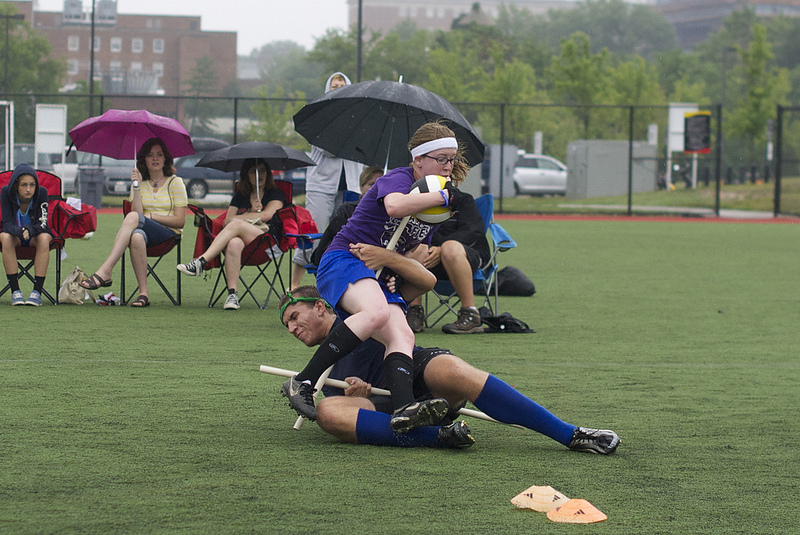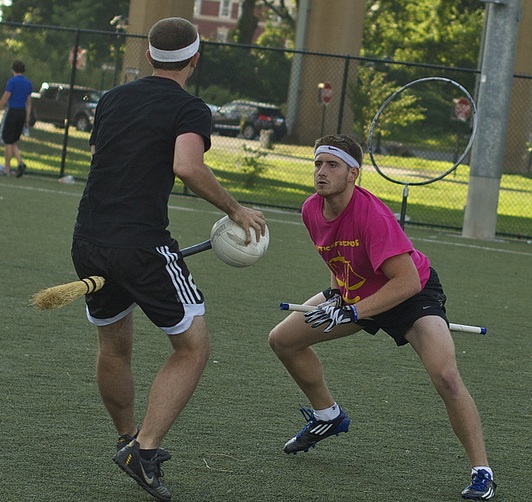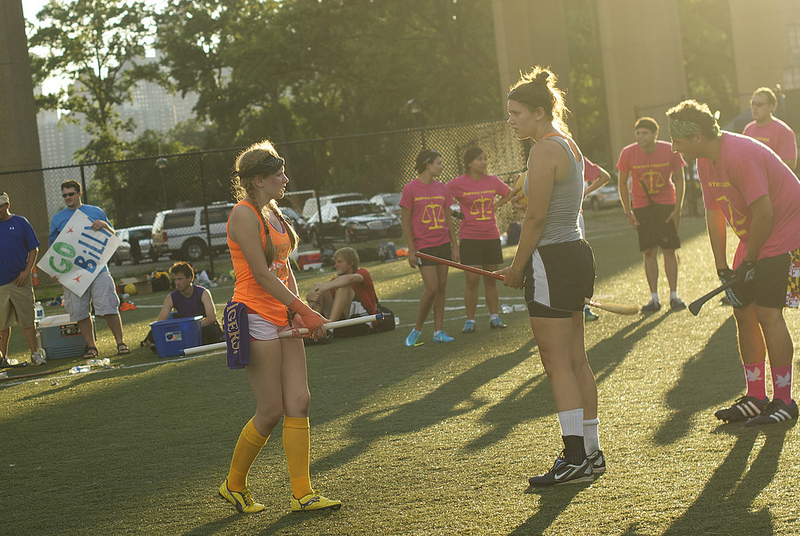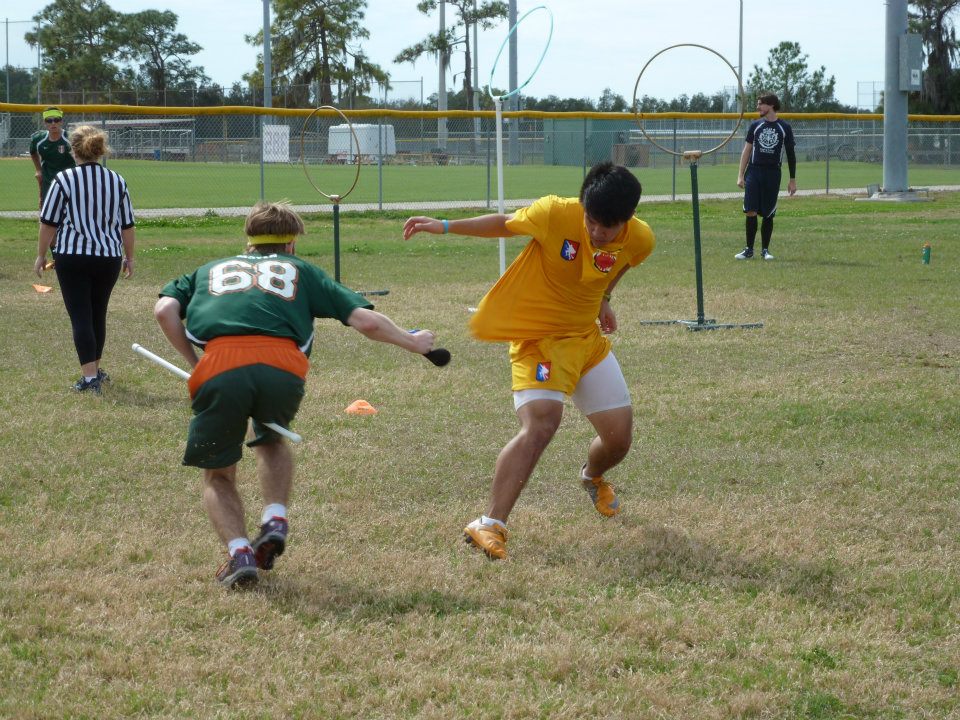- Rule, Britannia, no more?
- Unpopular Opinions: US Quadball Cup 2023
- Proven Contenders: University of Virginia
- Proven Contenders: Rutgers University
- Proven Contenders: University of Michigan
- Proven Contenders: Creighton University
- Different Perspectives: A Look Inside USA Ultimate
- Antwerp QC, Much of Belgian Core, Leaves Competitive Quidditch
Finding the Facts in the Fantasy
- Updated: November 1, 2012


While the tournaments might have been called fantasy, there was nothing light-hearted about the style of play. Credit: Deanna Edmunds
Whether you want to admit it or not, quidditch in its current state is an unfair game. As hard as they try, small liberal arts colleges can’t keep up with the state school behemoths in terms of recruiting and available athletic talent. The proof is in the numbers: a sport that just two years ago pitted Tufts University against Middlebury College in the World Cup final now has seven of its top eight teams in The Eighth Man’s rankings hailing from schools with student bodies of at least 20,000 undergraduates. That’s before we even get into the plight of community teams, who have to recruit in places without the built-in social web of a college campus.
All of this is what made this summer’s series of fantasy tournaments so compelling. Each captain had hypothetically the exact same resources to build a team with, be it the number of draft picks or a starting budget to go to auction with. While other factors, including scouting and draft strategy, also played into the results, the basic tenet of success was their early picks or how they spent their money. This distinguished one team from another, and determined success or failure.
With the unique opportunity presented by examining the data from these tournaments, this article will analyze the draft styles of the captains to attempt to quantify the importance of different positions in the success of a fantasy quidditch team. The article will focus on stud picks, which are arbitrarily defined as players either drafted in the first four rounds of a snake draft or auctioned off for 100 galleons or more.
Of course, there are holes in this study. The first is sample size – with only 15 teams to look into, the information drawn from the data will only be so accurate. There is also issues of captains simply drafting poorly. That being said, the fantasy tournaments seemed like too good of an opportunity to pass up.

Jason Rosenberg’s aggressive defense was a key to his team’s victory at the Northeast Fantasy Tournament. Credit: Deanna Edmunds
| Studs | Teams | Combined Win Percentage | Championships |
|---|---|---|---|
| 3 | 1 | 66.7% | 0 |
| 2 | 5 | 57.7% | 1 |
| 1 | 7 | 51.6% | 2 |
| 0 | 2 | 22.2% | 0 |
We start with one of the more difficult tables to analyze. With the results similar whether the team has one, two or three studs, the only real judgement to make is that a team cannot win without at least one very talented chaser.
In today’s game, you need at least one player with the strength and athleticism to both play the point on defense and go end-to-end against a bludgerless defense on offense. Multiple studs are great to have, both for depth and to fill out the whole chasing line, but it’s that one player that is the true difference between the haves and have nots.
The Northeast fantasy winning team got that production out of underrated Penn State University chaser Jason Rosenberg, who has often been overshadowed by Michael Parada but impressed everyone at the tournament.
What this means is that focusing all of your athleticism into your chasing game is not a necessity. As we’ll see later, male beaters and seekers are infinitely more important, so once you find those one or two elite male chasers, it may be frugal to turn your other top athletes elsewhere.
| Studs | Teams | Combined Win Percentage | Championships |
|---|---|---|---|
| 1 | 4 | 40.0% | 0 |
| 0 | 11 | 53.7% | 3 |
There isn’t much to see here. The female chaser position is often under-appreciated, but the numbers here support that notion, finding in a small sample that an elite female chaser is simply not necessary. This doesn’t mean that teams should switch to a two female beater setup — this will be discussed further below — simply that the position of female chaser hasn’t developed yet. It’s also worth mentioning that many of the most storied female chasers in quidditch, including all but one of the Team USA female chasers, hail from the Southwest and West, which aren’t heavily represented in these tournaments.
The only female chaser on a team that found moderate success was the University of Maryland’s Erin Mallory at the Mid-Atlantic tournament. Mallory was playing with multiple other players from her school team that she has past chemistry with, and has a varsity basketball background that makes her a threatening player. These could be the key components of potent female chasers in the future.
| Studs | Teams | Combined Win Percentage | Championships |
|---|---|---|---|
| 2 | 2 | 44.4% | 0 |
| 1 | 8 | 65.1% | 3 |
| 0 | 5 | 21.7% | 0 |
To begin, we’ll talk about the outlier data, the teams with two stud beaters. Throughout the fantasy tournaments, no team went to a two-male beater setup with any regularity. Thus, having two male beaters that were expensive to obtain when only one could be on the field at a time was simply poor draft management. These numbers do not mean that having two good male beaters on your team is a bad thing.
Moving past those two teams, we see one of the most telling stats in this analysis: teams with a stud beater had a 43.4% higher chance of winning than a team without one. This is the biggest gap at any position between having one stud and not having one.
The truth of the matter is that a single talented male beater can take over a game in a way no other position can. It’s what made Jeffrey Hunt, who graduated from the University of Richmond in the spring, the most compelling and vital player at Mid-Atlantic fantasy. His hyper-aggressive beating play, in which his set position would often be all the way in the opponent’s defense end, was able to take entire chasing lines out of a game if the opposition couldn’t counter with a skilled beater of their own.
The top teams in the Northeast each had an elite beater of their own: University of Rochester’s Harry Clarke, University of Maryland’s Ricky Nelson, and University of Miami’s Matthew Ziff. The Midwest fantasy champions did it with Michigan State University’s 6-foot-1 Dan Snyder.
If you are team with a deep, talented male chaser line but a lack of male beaters, converting a couple players may be a necessity for you.

Sarah Kneiling (left) and Heather Knoch (right) were the two most expensive female beaters at the Northeast Fantasy Tournament, but were vital in getting their teams to the finals. Credit: Deanna Edmunds
| Studs | Teams | Combined Win Percentage | Championships |
|---|---|---|---|
| 2 | 2 | 22.2% | 0 |
| 1 | 4 | 70.0% | 1 |
| 0 | 9 | 45.7% | 2 |
There are two lessons to be learned here. The first is that the idea of using two girls as beaters and none as chasers is — or at least should be — dead. Two different teams attempted this: Pitch Slap in the Mid-Atlantic and Sarah Woolsey Likes this Team (SWLT) in the Northeast. They went a combined 2-7. The SWLT had an especially impressive line of female beaters, including Macaulay University’s Jenna Jankowski and namesake Sarah Woolsey, from the University of Maryland, but still underwhelmed.
The other lesson is that having at least one talented female beater, much like having at least one top male beater, is a must. In the finals of the Northeast tournament, it was clear that the best two female beaters there — Louisiana State University’s Sarah Kneiling and Empire Heliopaths’ Heather Knoch — were on the pitch. In the Midwest, the purple team utilized Purdue University’s Miranda Sanderlin, the only female beater picked early in that tournament, to produce a perfect 3-0 record in pool play.
When comparing these numbers to those found in the female chaser section, it’s clear that having a talented female beater is much more important to team success. Yet, many teams continue to train their most athletic females to be chasers. This is a trend that teams would be wise to stop, because the more 5-foot-11 Heather Knochs there are in the bludger game, the better teams will become.
| Studs | Teams | Combined Win Percentage | Championships |
|---|---|---|---|
| 2 | 1 | 20.0% | 0 |
| 1 | 8 | 44.1% | 2 |
| 0 | 6 | 65.6% | 1 |
One of the most surprising aspects of this data is the relative unimportance attributed to keepers in success at these tournaments. Sure, teams with one stud keeper won two of the three tournaments, but one-keeper teams were also the majority, and came away with just a 44.1% winning percentage.
It wasn’t for a lack of talented and highly athletic keepers either. Maryland’s James Hicks attended both the Mid-Atlantic tournament — where he was the first pick overall — and the Northeast tournament, but his teams only went a combined 2-7. Ex-Penn State keeper Tony Greco was expected to be the anchor of a dominant offensive black team in Northeast, but the team instead stumbled to a 2-4 record, while first pick keepers Tyler Rafferty of Michigan State University and Isaac Mitchell of Illinois State University in the Midwest could only bring their teams to a combined 3-5.
The most likely explanation here is that a keeper simply doesn’t contribute enough to the actual process of winning. Even the top keepers are often satisfied taking the ball only up a little past midfield, electing to pass it from there. That means they aren’t helping get their team out of snitch range, nor are they catching the snitch. They are of course involved in point prevention, but defense in quidditch remains a complex puzzle that is far from cracked. This isn’t to say that your team won’t benefit from a talented keeper, only that it might be worth it to move your most athletic players to the chaser position, where they can contribute more on offense, or to simply teach your keeper to play more aggressively.

David Moyer (left), seen here at a tournament in Florida, almost won his team the Midwest Fantasy Tournament by himself. Credit: Jeremy Sparks
| Studs | Teams | Combined Win Percentage | Championships |
|---|---|---|---|
| 1 | 5 | 52.0% | 2 |
| 0 | 10 | 49.0% | 1 |
This information can be a little tougher to decipher, because the win percentages for picking up a stud seeker or choosing not to are not very different. But the telling number is the championships: two of the five teams with elite seekers won their tournaments, while only one of the 10 teams without one did the same. In both championship cases, the seeker was at the heart of the team’s success.
Villanova’s Billy Greco made a regulation grab and an overtime grab in a grand total of two minutes of on-field snitch action to earn the Justice Friends the top seed, and then caught an early returning snitch that had camped out on the far side of the pitch from his hoops in the semifinals.
Miami’s David Moyer, meanwhile, made an off-field grab in the semifinals to beat a loaded red team at Midwest Fantasy, and then had a tremendous snatch on-pitch in the finals against a very capable snitch in Daniel Daugherty. Moyer leaped over Daugherty and grabbed the snitch before face-planting into the ground, giving his team a 70-50 victory.
The takeaway here is that an underwhelming team can quickly make its seeker irrelevant, but if a squad is good enough to keep things competitive, there is no asset more important in a single-elimination bracket than a talented seeker. Middlebury, Tufts and the University of Florida have all proven it at the World Cup, and Greco and Moyer proved it at fantasy.
Wrapping it all up
So, what did we learn today? In a game where people are paying more and more attention to the hard hitting, physical play of the chaser game, it’s the guys and girls holding the dodgeballs that have the power still. And when you are looking to make a tournament run, much like with a goalie in hockey, a hot seeker is key. Does this mean the game is unbalanced, or do chasers just have more room to improve? The answers will define the sport well into the future, and next year’s fantasy tournaments will surely have many new things to tell us.
(This article incorrectly identified Isaac Mitchell as attending Ball State University. He actually attends Illinois State University.)

9 Comments